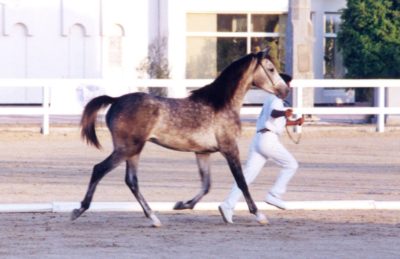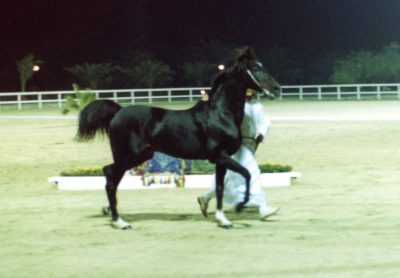The little known strain of Kuhaylah Umm Surayr
I came back from Bahrain with my head swirling with images of desert-bred Arabians, which still look like the way Arabians ought to look like (read: not like China dolls or sea horses or “living art”). One of the strains that survive over there — and nowhere else — is that of Kuhaylah Umm Zorayr, with a precious few mares left at the Royal Stud (below, a yearling from that strain in 1998, second photo credit Kina Murray).


In her “pearls of great price” article series, Judi Forbis mentions the strain in passing among the many strains Bahrain had preserved by the early 1970s, but without elaborating further. There is a bit more information on the website of the Royal Stud, which relates the wonderful story of an old black mare of that strain that was first believed to be way past breeding age, but when put back in training in 1969, produced a daughter that carried the line forward. I thought this was all there was.
Then, while flipping through the Abbas Pasha Manuscript — that bottomless treasure — I came across “the History of Kuhayla om Sareer, and Her Name is Dahma”, on pages 580 and 581 of the English language edition, and it occurred to me that this was the same strain, despite the slightly different spelling. From the testimony of Hizam ibn Hathleen, the leader of the ‘Ajman Bedouins, in the Manuscript:
“And the reason for her being called this is that her milk stopped flowing and her foal could not suckle. And they called her Kuhayla om Sareer, because her teats dried up. But otherwise she is Kuhayla ‘Ajuz of the horses of Beni Khaled.”
Some Arabic etymology is in order here. According to the Lesan al-Arab, the reference Arabic dictionary from the XIVth century, the Arabic verb “sarra” as applied to a she-camel, a mare, a goat, etc, means “to fasten its udder”; and a “sirar” is the string used to fasten the udder so that foals, calves, kids, etc, do not suckle. In the same dictionary, XIIth century Arab historian and linguist Ibn al-Athir is quoted as writing that [translation mine] “one Arab custom is to tie up the udder of milk-producing animals [with a string] when sending them to graze, and to undo the string and milk them upon their return in the evening“.
The word “surayyir”, a diminutive, is a small “sirar”, a small string to faster an udder. Hence the strain name, as it should be written and pronounced: Kuhaylah Umm Surayyir, or “Kuhaylah of the small string that ties the udder”. Accordingly, the spelling “om Sareer” in the English translation of the Abbas Pasha Manuscript is incorrect. The editors seem to have vocalized the word as if it was not a diminutive, “sareer” and its diminutive “surayyir” being written in the same way in the absence of vocalization. The spelling “Umm Zorayr”, as adopted in Bahrain, is closer to the original “surayyir”, and seems to be a local variant, unless it was so transcribed by Dana al-Khalifah, the source of much of the English language materials about Bahraini horses.
Another reason other than etymology for the equivalence of the two strains of “om sareer” and “umm zorayr” has to do with color. The Kuhaylah “om sareer” in the Abbas Pasha Manuscript “was called al Dahma […] because she is sawdah [black]“, and all the horses from the strain were also known as Duhm, according to the Manuscript [Note: not the same as the Dahman strain]. The old matriarch of the Bahraini offshoot of the strain and subject of the story cited above, Kuhaylat Umm Zorayr 186, was also black, as so was her handsome grandson Kuhaylan Umm Zorayr Al-Dheleem 407 (photo below, photo credit Kina Murray in 1998), in a breeding program where black horses are rare.

By the way, and as an aside, the male version of the strain name poses something of a conundrum. One should not write “Umm” (mother) after the male noun Kuhaylan, but rather “Abu”, as in Kuhaylan Abu ‘Arqub, Abu Janub, or Ubayyan Abu Jreyss, etc, but in this specific case, the problem is that male horses obviously don’t have udders to fasten. The right reference to the strain name should therefore be: “Kuhaylan Wuld Umm Surayyir/Zorayr”, or “Kuhaylan son of the mare with the fastened udder”, rather than “Kuhaylan with the fastened udder”. Footnote: There is a similar case with another strain, no doubt for the same reason: [Kuhaylan] Ibn Umm Soura, also in the Abbas Pasha Manuscript. We don’t say Kuhaylan Abu Soura.
A third reason is the mention on the Bahrain Royal Studs website that “the stallions of this strain were much used for stud in the Najd in the mid 19th century”. Indeed, the Abbas Pasha Manuscript section on the Kuhaylah Om Sareer mentions at least two specific instances of using stallions of that strain as breeding stallions, one of these instances by Faysal Ibn Turki for his stud in Najd. Oh, the fascinating stories behind these desert Arabians.
Thank you, very interesting Text.
Love this level of education Edouard. What an amazing trip to Bahrain that must have been!
DataSource traces the modern strain to KUHEILAT UMM ZORAYR (186), a black mare of unknown age who produced a bay filly, KUHEILA’T UMM ZORAYR SSARFA, in 1971. During the 1980s, the bay produced a colt and three fillies. I have some of the Bahraini stud books at home as well as a copy of the “Living Treasures” booklet. I’ll have to see if there is any more information on this strain.
My copies are back in Lebanon.. the colt is the stallion pictured above.
GORGEOUS FILLY!!
What a lovely way to spend an evening, strolling through your photos and memories of such an educational visit. Many thanks to Kina Murray for her camera work and generosity in sharing!
Bahraini stud book volume 1 (1980) tells the story of the old black mare Kuheilah Um Zorayr Nr. 186 who had not shown heat in years but was put back in race training and then started acting like she was young again. She produced just the one foal, her 1971 daughter, and then died in December, 1974. Her daughter, found on page 51, is the only animal of this strain in the entire book.
I don’t see any mention of the strain in Living Treasures (1971).
Stud book volume 2 (1992) follows the family forward, but does not give any further back story.
By the way, each time the Abbas Pasha Manuscripts refers to the “Kuhaylan whose name is Dahman” of Faysal ibn Turki — and these are dozens of reference to him — it’s a reference to a horse from this strain.
These seem to have been known as “al-Duhm”, the “black ones”.
pearl of great price is biblical possibly older -a parable about finding the treasure of heaven and like the merchant looked everywhere for the perfect pearl and having found it gave everything he had to possess it. for many here on earth the pursuit of the arabian horse is much like that precious pearl of great price in this life. symbolically, ironically and in resemblance these horses are pearls of great price.
From the Bahrain Royal Stud website:
“The Kuheila’t Umm Zorayr strain is of great antiquity but rarely heard of in modern breeding progammes, although the stallions of this strain were much used for stud in the Najd in mid 19th century.
In Bahrain we were most fortunate to have one survivor of this strain. In 1969 old studmaster Fatis realized that in the herd of broodmares in his charge there was only one Kuheila’t Umm Zorayr, a very old black mare that used to be one of Shaikh Sulman’s favourite racing mares. This mare had not produced anything for many years nor had she shown any interest in the stallions- so she had been left to retirement of her own choosing. Fatis took her up to the Palace and put her in race training! Obviously the stimula of running and the special personal attention made the old girl think she was young again. She was mated with Jellaby Wasmiya and produced a filly foal. She died peacefully in December 1974 – toothless, deaf and half-blind yet contented. This daughter Kuheila’t Umm Zorayr Ssarfa 154 had three daughters of her own and so this historical strain can be still be appreciated by future generations.”